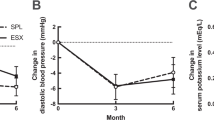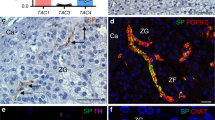Abstract
KAGAWA1 reported that the spirolactone SC 5233 (3-(3-oxo-17β-hydroxy-4-androsten-17α-yl)propionic acid lactone) possessed weak cortexone-like activity in addition to its well-known antagonistic action towards cortexone and aldosterone. This weak cortexone-like (agonist) activity was estimated at 0.1–0.2 per cent that of cortexone. Reported here are some effects of SC 5233 on electrolyte excretion in normal and adrenalectomized rats which cannot be explained purely on a weak agonist activity.
This is a preview of subscription content, access via your institution
Access options
Subscribe to this journal
Receive 51 print issues and online access
$199.00 per year
only $3.90 per issue
Buy this article
- Purchase on Springer Link
- Instant access to full article PDF
Prices may be subject to local taxes which are calculated during checkout
Similar content being viewed by others
References
Kagawa, C. M., Clinical Use of Aldosterone Antagonists, edit. by Bartter, F. C., 33 (C. C. Thomas, Springfield, Illinois, 1960).
Davey, M. J., and Lockett, M. F., J. Physiol., 152, 206 (1960).
Liddle, G. W., in Clinical Use of Aldosterone Antagonists, edit. by Bartter, F. C., 33 (C. C. Thomas, Springfield, Illinois, 1960).
Mills, J. N., Thomas, S., and Williamson, K. S., J. Physiol., 155, 18, P (1961).
Author information
Authors and Affiliations
Rights and permissions
About this article
Cite this article
FARMER, J., PETCH, B. Electrolyte Retention produced by the Antialdosterone SC 5233. Nature 191, 1308–1309 (1961). https://doi.org/10.1038/1911308a0
Issue Date:
DOI: https://doi.org/10.1038/1911308a0
Comments
By submitting a comment you agree to abide by our Terms and Community Guidelines. If you find something abusive or that does not comply with our terms or guidelines please flag it as inappropriate.



